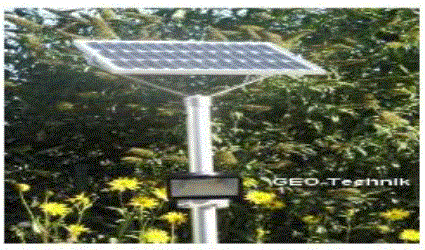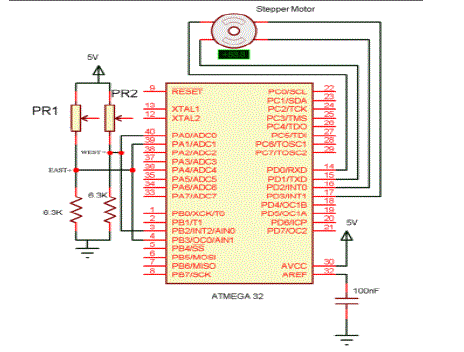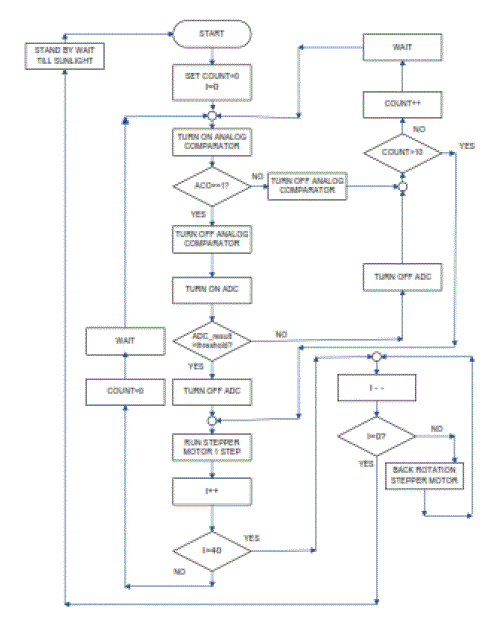Keywords
|
| Solar panel, charge controller, Intensity regulator, Solar tracker |
INTRODUCTION
|
| Thesurface of the Sun has a temperature of about 5,800 Kelvin (about 5,500 degrees Celsius, or about 10,000 degrees Fahrenheit),as per the say of NASA, At that temperature, most of the energy the Sun radiates is visible and nearinfrared light. At EarthâÃâ¬ÃŸs average distance from the Sun (about 150 million kilometres), the average intensity of solar energy reaching the top of the atmosphere directly facing the Sun is about 1,360 watts per square meter, according to measurements made by the most recent NASA satellite missions. This amount of power is known as the total solar irradiance. (Before scientists discovered that it varies by a small amount during the sunspot cycle, total solar irradiance was sometimes called “the solar constant.” |
| Averaged over the entire planet, the amount of sunlight arriving at the top of EarthâÃâ¬ÃŸs atmosphere is only one-fourth of the total solar irradiance, or approximately 340 watts per square meter. |
SOLAR TRACKER
|
| Solar tracking system[1] is the most appropriate technology to enhance the efficiency of the solar cells by tracking the sun. A microcontroller based design methodology of an automatic solar tracker is presented in thispaper. Light dependent resistors are used as the sensors of the solar tracker. |
| The sun is the prime source of energy, directly or indirectly, which is also the fuel for most renewable systems. Among all renewable systems, photovoltaic system is the one which has a great chance to replace the conventional energy resources. Solar panel directly converts solar radiation into electrical energy. |
| Solar panel is mainly made from semiconductor materials. Si used as the major component of solar panels, which ismaximum 24.5% efficient [2]. Unless high efficient solar panels are invented, the only way to enhance the performance of a solar panel is to increase the intensity of light falling on it. Solar trackers are the most appropriate and proven technology to increase the efficiency of solar panels through keeping the panels aligned with the sunâÃâ¬ÃŸs position. Solar trackers get popularized around the world in recent days to harness solar energy in most efficient way. This is far more cost effective solution than purchasing additional solar panels [3]. |
TECHNOLOGY TO ENHANCE POWER OUTPUT FROM SOLAR PANEL
|
| Increasing the cell efficiency, maximizing the power output and employing a tracking system with solar panel are three ways to increase the overall efficiency of the solar panel[4]. Improvement of solar cell efficiency is an ongoing research work and people throughout the world are actively doing research on this. Maximizing the output power from solar panel and integrating solar tracking system are the twoways where electronic design methodology can bring success. |
| Maximum power point tracking (MPPT) is the process to maximize the output power from solar panel by keeping the solar panelâÃâ¬ÃŸs operation on the knee point of P-V characteristics. |
| A number of MPPT algorithms have been developed and employed around the world [5]. MPPT technology only offers the maximum power that can be received from a stationary array of solar panels at a particular time; it cannot, however, increase the power generation when the sun is not aligned with the system. Automatic solar tracker increases the efficiency of the solar panel by keeping the solar panel aligned with the rotating sun. |
| Solar tracking is a mechanized system to track the sunâÃâ¬ÃŸs position that increases power output of solar panel 30% to 60% than the stationary system [6]. A few design methodology of solar tracking system has been proposed in recent days [7]-[9]. |
MICROCONTROLLER
|
| The ATMEGA32 microcontroller has been used in the prototype. Microcontroller is the heart of overall system.ATMEGA32 microcontroller requires a 5 volt regulated voltage supply. „7805âÃâ¬ÃŸ voltage regulator is used to providefixed 5 volts supply to the microcontroller .ATMEGA32 has some features such as analoge comparator (AC), analog to digital converter (ADC), universal synchronous asynchronous receiver transmitter (USART), times etc. [13]. Utilization procedure of these features is given below: |
| 1)Analog comparator: |
| There are two pins which are known as analog input 0 (AIN0) and analog input 1 (AIN1). Two analog voltage signals coming from two junctions of photo resistor circuit are fed to these pins. There is a bit called analog comparator output (ACO) which is set to either „1âÃâ¬ÃŸ or „0âÃâ¬ÃŸ. |
 |
| 2) Analog to digital converter: |
| Among 8 analog to digital converter input pins ADC0 and ADC1 have been used; where VVt ,is expected. Differential input is converted into digital value and the most 8 significant bits are defined 10 ADCADCasADC_result to compare with threshold. |
| ADC_result= [VADC0 – VADC1] |
| digital |
| This threshold value, set according to the photo resistor response against the solar radiation intensity, is provided, sinceADC_result alone might be insufficient for rotation of motor. And if ADC_result> Threshold; motor rotates one step. |
| 3) Timers: |
| Built-in timer of ATMEGA32 is utilized to create delay. The Earth rotates on its own axis, with respectto the sun 360° in a day and so it rotates, (360°/24=) 15° an hour or 3.75° in 15 minutes. Delay for 1.5 minutes and 15 minutes are required. These delays are mentioned as short delay and moderate delay respectively. The lasthour before sunset will provide additional energy to rotate thepanel in the initial position and so the tracker no more rotatesto the west rather it will rotate reversely. As 2 hours in day time are not considered for tracking, (2Ãâò15°=) 30° of rotationis not required to be done by the solar tracker. Half stepping of stepper motor is considered which gives 3.75° rotation ineach stepping; approximately ((180°-30°)/3.75°=) 40 rotations are required in each day to track the sun at daylight. |
| Count is used for counting the number of „waitâÃâ¬ÃŸ states when weather is cloudy and ADC does not permit to rotate the motor. |
CHARGE CONTROLLER
|
| A charge controller monitors the state-of-battery to insure that when the battery needs charge-current it gets it, and also insures the battery isn't overcharged. Connecting a solar panel to a battery without a regulator seriously risks damagingthe battery and potentially causing a safety concern. |
| Charge controllers (or often called charge regulator) are rated based on the amount of amperage they can process from a solar array. If a controller is rated at 20 amps it means that you can connect up to 20 amps of solar panel output current to this one controller. The most advanced charge controllers utilize a charging principal referred to as Pulse- Width-Modulation (PWM) - which insures the most efficient battery charging and extends the life of the battery. Even more advanced controllers also include Maximum Power Point Tracking (MPPT) which maximizes the amount of current going into the battery from the solar array by lowering the panel's output voltage, which increases the charging amps to the battery - because if a panel can produce 60 watts with 17.2 volts and 3.5 amps, then if the voltage is lowered to say 14 volts then the amperage increases to 4.28 (14v X 4.28 amps = 60 watts) resulting in a 19% increase in charging amps for this example. |
| Charge controllers also offer Low Voltage Disconnect (LVD) and Battery Temperature Compensation (BTC) as an optional feature. The LVD feature permits connecting loads to the LVD terminals which are then voltage sensitive. If the battery voltage drops too far the loads are disconnected - preventing potential damage to both the battery and the loads. BTC adjusts the charge rate based on the temperature of the battery since batteries are sensitive to temperature variations above and below about 75 F degrees. |
| 1)Battery: |
| The Deep Cycle batteries used are designed to be discharged and then re-charged hundreds or thousands of times. These batteries are rated in Amp Hours (ah) - usually at 20 hours and 100 hours. Simply stated, amp hours refers to the amount of current - in amps - which can be supplied by the battery over the period of hours. For example, a 350ah battery could supply 17.5 continuous amps over 20 hours or 35 continuous amps for 10 hours. To quickly express the total watts potentially available in a 6 volt 360ah battery; 360ah times the nominal 6 volts equals 2160 watts or 2.16kWh (kilowatt-hours). Like solar panels, batteries are wired in series and/or parallel to increase voltage to the desired level and increase amp hours. |
| The battery should have sufficient amp hour capacity to supply needed power during the longest expected period "no sun" or extremely cloudy conditions. A lead-acid battery should be sized at least 20% larger than this amount. If there is a source of back-up power, such as a standby generator along with a battery charger, the battery bank does not have to be sized for worst case weather conditions. |
| The size of the battery bank required will depend on the storage capacity required, the maximum discharge rate, the maximum charge rate, and the minimum temperature at which the batteries will be used. During planning, all of these factors are looked at, and the one requiring the largest capacity will dictate the battery size. |
| In this specific application, and taking into account thechanges of solar radiation during the day and, consequently, the energy available, the battery bank charge algorithm willpresent three different modes: |
| • If the panel available current is lower than 0.1CAh, the converter will find the maximum power point (MPPT)in order to provide the highest current possible for thebattery bank (area under the current level, see figure 2). |
| • If the panel available current is higher than 0.1CAh, theconverter limits the current to 0.1CAh, and disables thesearch for the maximum power point. |
| • If the batteries are already charged, the control algorithm will apply a constant voltage level, in order to keep thebatteries charged. |
| Lead-acid batteries are the most common in PV systems because their initial cost is lower and because they are readily available nearly everywhere in the world. There are many different sizes and designs of lead-acid batteries, but the most important designation is that they are deep cycle batteries. Lead-acid batteries are available in both wet-cell (requires maintenance) and sealed no-maintenance versions. AGM andGel-cell deep-cycle batteries are also popular because they are maintenance free and they last a lot longer. |
CONCLUSION
|
| This paper has studied about various advancements in the field of solar based LED street light. the use of solar tracking system has greatly increased the system and has helped to increase its overall output. |
| Whereas the use of charge control circuit in the solar based LED street light has not only helped in saving the battery power but also in preventing the battery from getting deep discharged, overcharged, thereby conserving a lot of energy. |
| |
Figures at a glance
|
 |
 |
 |
| Figure 1 |
Figure 2 |
Figure 3 |
|
References
|
- Design and Construction of an Automatic SolarTracking System Md. Tanvir Arafat Khan, S.M. ShahrearTanzil, RifatRahman, S MShafiulAlam*, Member, IEEE Department of Electrical and Electronic Engineering,
- International Energy Agency. Online. Available:http://www.iea.org/Textbase/nppdf/free/2009/key_stats_2009.pdf
- M. A. Green, “Clean Electricity from Photovoltaics,” Ed. Mary D.Archer and R. Hill, Series on Photoconversion of Solar Energy, V. 1,Imperial College Press, UK.
- M.A. Panait and T Tudorache, “A Simple Neural Network SolarTracker for Optimizing Conversion Efficiency in Off-Grid Solar Generator”Intl. Conf. on Renewable Energy and Power quality, no.278, March, 2008.
- Piao, Z.G. Park, J. M. Kim, J. H. Cho, G. B. Baek, H. L, “ A study on the tracking photovoltaic system by program type,” Intl. Conf. onElectrical Machines and Systems, vol. 2, pp. 971-973, Sept. 27-29, 2005.
- C. Hua and C. Shen, “Comparative study of peak power tracking techniques for solar storage system,âÃâ¬ÃŸÃ¢Ãâ¬ÃŸ Applied Power Electronics Conferenceand Exposition, vol. 2, pp. 679-685, Feb. 15-19, 1998.
- A. K. Saxena and V. Dutta, “A versatile microprocessor based controller for solar tracking,âÃâ¬ÃŸÃ¢Ãâ¬ÃŸ Photovoltaic Specialists Conference, vol. 2, pp.1105-1109, 1990.
- B. Koyuncu and K. Balasubramanian, “A microprocessor controlled automatic sun tracker,âÃâ¬ÃŸÃ¢Ãâ¬ÃŸ IEEE Transactions on Consumer Electronics,vol.37, no. 4, pp. 913-917, 1991.
- Design and Construction of an Automatic SolarTracking System Md. Tanvir Arafat Khan, S.M. ShahrearTanzil, RifatRahman, S MShafiulAlam*, Member, IEEE
|